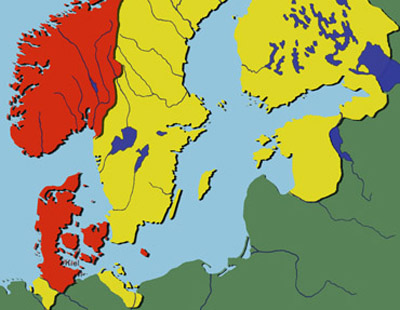| Introduktion

| | 1600-tallet er en af de mest dramatiske perioder i Øresundsregionens historie. Den første halvdel er præget af den danske konge Christian 4.s initiativer og eventyrpolitik samt Sveriges europæiske ekspansion.
Den sidste halvdel af Sveriges erobring af den danske landsdel, Skåne og enevældens indførelse i begge riger.
Ved århundredets slutning ligger grænserne mellem de to stater fast.
|
1600-tallet er en særdeles omskiftelig periode i Øresundsregionens historie. Der er bl.a. her Skånelandene fra 1658 overgår fra Danmark til Sverige.
Første del af århundredet er præget af fortsat økonomisk vækst. De fyrstelige pragtbyggerier Under Christian 4.(1588-1648) udvides med bl.a. Rosenborg Slot, nye byer grundlægges og København udvikles til residenshovedstad. Riget er stadigvæk et valgkongedømme, kongen må underskrive en håndfæstning og regere i samråd med adelen, men mange træk peger i retning af den centraliserede og bureaukratiske enevælde, der indføres i 1660.
Dagligdagen er præget af at staten, og hermed også den protestantiske statskirke, forsøger at regulere en lang række forhold omkring den enkeltes levevis, eksempelvis vedrørende ægteskab og samliv. Fattigdommen er udbredt i de laveste sociale lag, prostitutionen er omfattende, men afvigere tåles ikke gerne. Antallet af hekseprocesser vokser og kulminerer i 1600-tallets første halvdel.
Renæssancetidens militære udfoldelser kommer til udtryk i en række krige i 1600-tallet, men eksempelvis også i tidens byplanlægning og arkitektur. Med enevældens indførelse i 1660 begynder barokkulturen at gøre sig gældende. Det iagttages f.eks. i havearkitekturen.
Størstedelen af 1600-tallet er Øresundsregionen præget af kampen imellem de to regionale stormagter Danmark-Norge og Sverige om herredømmet over Øresund og Østersøen. Sverige, som er inde i en rivende udvikling med eksport at råvarer, såsom jern, kobber, træ til skibsbygning og også landbrugsvarer, øler sig i høj grad spærret inde af Danmark-Norge.
Øresund og opkrævningen af Øresundstolden blev brændpunkt for konfrontationerne. Den nordiske Syvårskrig 1563-70 slår temaet an og med Kalmar-krigen 1611-13 kommer en konfrontation, som umiddelbart falder ud til Danmarks fordel. I 1640erne må Danmark imidlertid se sig besejret af svenskerne i alliance med hollænderne og må afgive landområderne Gotland, Øsel og Halland for en 30årig periode.
I 1657-58 indtræffer katastrofen, set med danske øjne, for alvor. Store dele af de danske landområder bliver løbet over ende og ved Roskilde-freden i 1658 må Danmark afgive Skånelandene til Sverige. Et halvt år senere vender svenskekongen tilbage, men København undsættes af hollænderne, som nu er dansk alliancepartner. Der sluttes atter fred i København i 1660.
Revanchekrigen Den Skånske Krig i perioden 1676-79 falder ud til Sveriges fordel, men det er nu åbenlyst at magtforholdene omkring Øresund er et led i europæiske stormagtsinteresser.
Snaphanemodstanden i Skåne var i visse egne markant og efter Skånske Krig sætter en forsvenskningsproces ind. Det er dog også led i en generel uniformeringsproces, hvor statsmagtens beføjelser øges, hvilket kan iagttages både i Sverige og Danmark efter enevældens indførelse. I Skåne satses bl.a. på en centralisering omkring Landskrona, på Sjælland forstærkes Kronborgs befæstning og oplevelsen af Øresund som grænseskel vinder frem.
En ting er sikkert: Beboerne på begge sider af Øresund betaler prisen for de mange krigshandlinger. Befolkningsnedgang, ødegårde og sygdomsepidemier taler sit tydelige sprog. |